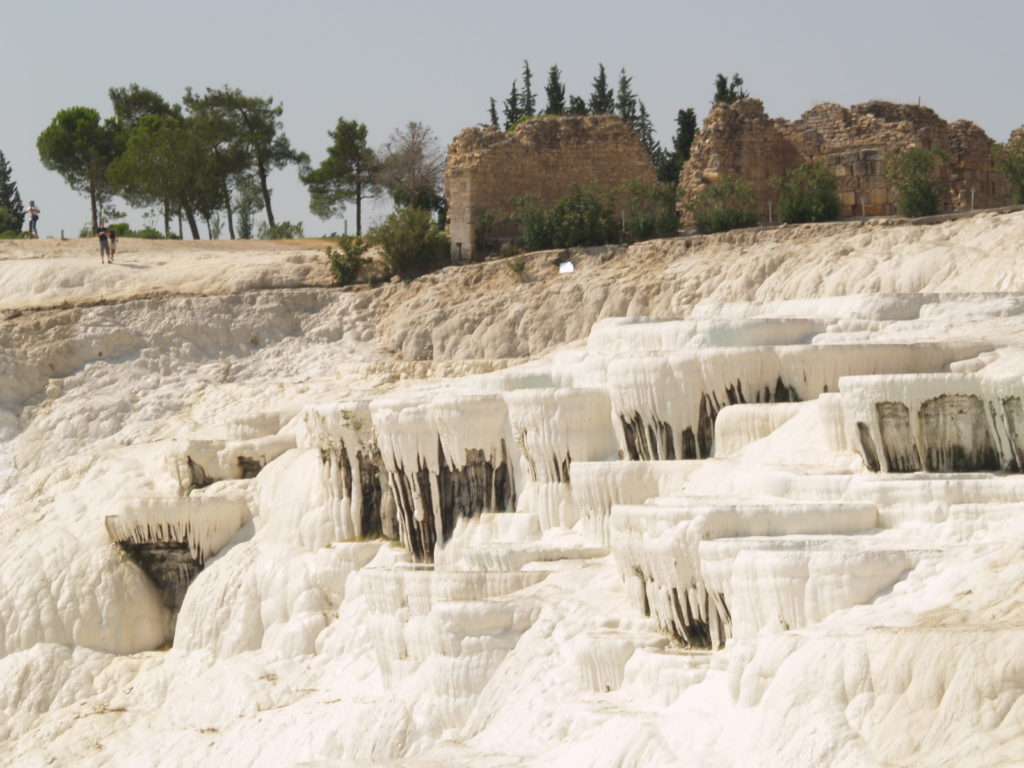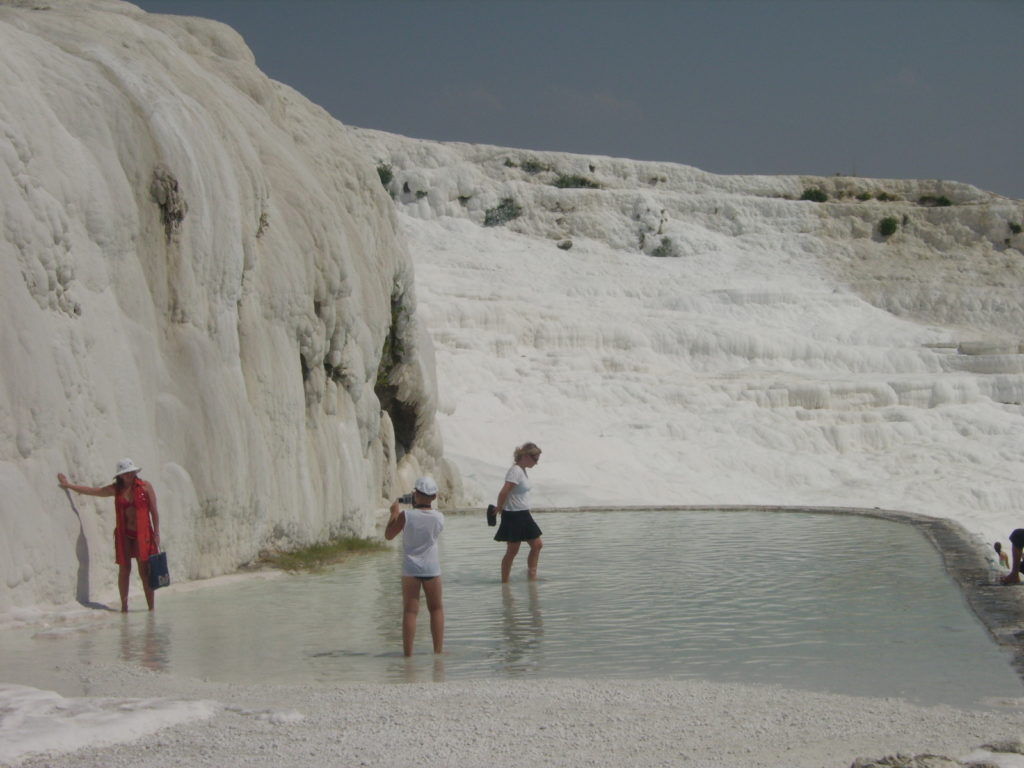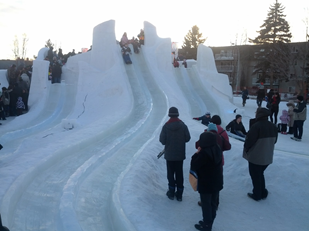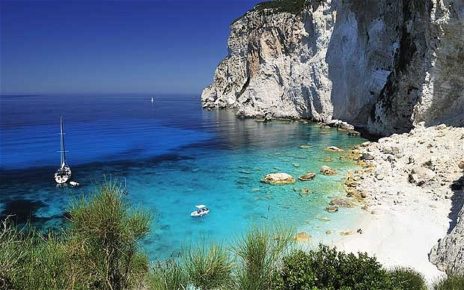Pamukkale Turkey is best known for its stunning snowscape of calcium pools which cling to the slopes of lush green hills. Located in southwestern Turkey just a few hours drive from both the Aegean sea and the Mediterranean coastline, thousands of tourists visit this natural wonder each year, so the pools can get a little crowded in the summer. However there are a plenty more places around Pamukkale that are worth exploring.

Travertine Pools
While these natural thermal bath tubs can get more than a little cosy in the summertime, they are still the main attraction of the region and for good reason. Aside from the novelty of swimming in cotton white pools of thermal water, this site also offers spectacular views over the area, particularly at sunset when the water reflects the amber glow of the sun.

Hierapolis Ancient City
Just a few minutes for the famous pools is the Ancient Spa city of Hierapolis. First built by King Eumenes II of Pergamon as a military colony around 190 BC the humble city was destroyed by an Earthquake around 60 AD. Rebuilt by the Greeks and conquered by the Romans who made use of the region’s natural resources and turned this military base into a luxurious spa city. The site was still a fully functioning city with a large theatre, necropolis, Byzantine church, colonnaded street which continues for 1 km beneath the travertine pools. Nearby lies the Temple of Apollo and the remnants of a once glorious Agora.

Hierapolis Museum
Within the walls of the ancient city is the Hierapolis museum. Historians have turned the former Roman Bath House into an extensive museum with impressive displayed of stone work, sculptures and artifacts that have been gathered from the city of Hierapolis itself as well as from other historical sites in the region.
Sacred Pools
After you’ve bathed in the ‘Cotton Castle’ and hiked back down the steep slope to Pamukkale village you might want to stop by the Hierapolis’ Sacred Pool and soak your weary legs. Said to be dedicated to the God, Apollo, the stone pool where Romans used to bathe is just next door to the Temple. The water has a constant temperature of 36℃ and the base of the pool is littered with broken marble columns from the ruined temple.
Sunset at the Castle
If you’re looking to avoid the crowds then you could pay a visit to Pamukkale’s real stone castle. Built around the 11/12th century the Pamukkale castle sits upon a plateau just outside of town, opposite the Cotton Castle and offers spectacular views of its famous neighbour. Visit by day for views across the mountainous landscape or make the climb in time for sunset to watch the light illuminate the travertine pools. You may have this spot completely to yourself.
Aphrodesias, Laodikeia and Colosea
By car or with by organised tour you can visit all three of these ancient sites in one day, or take your time and visit over a few days. Aphrodesias has become a prominent historical site in Turkey. Recent excavations have uncovered bronze age pottery and evidence dating back to the Hittite period of an Assyrian trading Colony. The area prospered during the Hellenistic and Roman era, but while little remains of the cities famous art schools, the Temple of Aphrodite still stands, as does the bouleuterion and the huge stadium.
Meanwhile Laodikeia was once a busy trading centre for the Roman Empire and home to the politician Cicero. The city was once inhabited by large number of Christians and Jews which has left behind a interesting combination of Roman, Early Christian and Byzantine temples and theatres, their ruins can be found scattered across a picturesque site.
Colosea is the least known of the three sites, with little left of the Phrygian City aside from views over of the surrounding hills, most decide to skip this ancient site. The once great city was once visited by St Paul but it was left to ruin when neighbouring cities began to prosper.

Denizli
Denizli is the capital of the province and was once a cultural hot pot made up of spa baths, bazaars and no less than seven mosque. After severe earthquakes in the 18th and 19th century, most buildings of historical importance were destroyed, however a visit to the modern city can still be a pleasant day out. Denizli hosts a good shopping sites and a fantastic variety of cafes and restaurants. A day in the city can make a nice change from the quiet towns and rural villages.
Hot Springs
In this region of Turkey thermal waters are literally bursting from the earth everywhere you look and aside from Pamukkale’s Cotton Castle and Sacred pool you might want to the dip into the chalky rock pool of Karahayit. Only 5 km from Pamukkale the colourful pools are filled with medicinal waters, at around 55℃ a bath in these red-hot waters is sure to heal any of your aches and pains.
Ephesus
Once you’ve visited the ancient sites close to Pamukkale you might want to venture a little further to see the UNESCO World Heritage Site of Ephesus. Set between the mountains only 20 km from the Aegean Sea, Ephesus was once a capital of Roman Asia and the prosperous Greek-Roman city is now the 2nd largest city of the ancient world. The site houses a colossal theatre with a capacity for 2,500 spectators, as well as a well preserved library and several temples. The area is also home to christian sites such as the Cave of the Seven Sleepers, the House of the Virgin Mary and St John’s Basilica. You could combine a trip to Ephesus with a day at the beach in Kusadasi.
Fethiye
The seaside town of Fethiye is around a 4 hour drive south of Pamukkale however it is an excellent place to begin or end your holiday in Turkey. Buses run frequently from Fethiye to Pamukkale and Ephesus and to other top destinations such as Cappadocia and Istanbul. Fethiye is a bustling port with a quirky old town, fresh fish market and seaside promenade. It’s a excellent place to base yourself for visiting exciting location on the Mediterranean Coastline before you head inland to explore the sights around Pamukkale.







